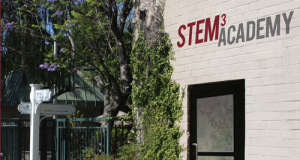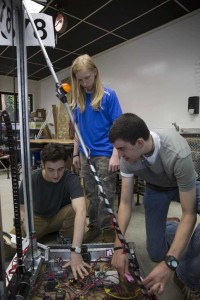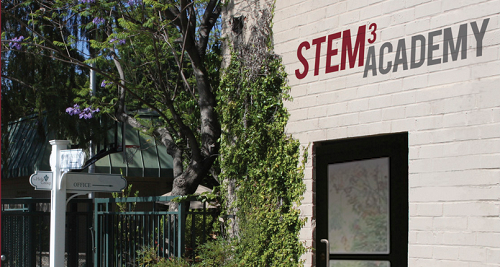A new STEM academy for those with learning difficulties focuses on hard and soft skills
 Eye-opening statistics about career readiness are seemingly everywhere these days, and nowhere is that more apparent than when it comes to the future of STEM, where jobs are rapidly growing — up to 17 percent from 2014 to 2024 by one estimate — and could reach 8.6 million by 2018. In that light, the scramble to provide students with hard skills, like robotics and coding, coupled with related soft skills, such as critical thinking and collaboration, seems only natural.
Eye-opening statistics about career readiness are seemingly everywhere these days, and nowhere is that more apparent than when it comes to the future of STEM, where jobs are rapidly growing — up to 17 percent from 2014 to 2024 by one estimate — and could reach 8.6 million by 2018. In that light, the scramble to provide students with hard skills, like robotics and coding, coupled with related soft skills, such as critical thinking and collaboration, seems only natural.
But in the world of special education, these numbers take on a special significance. Despite high unemployment and underemployment for autistic adults, for example, more than a third of students with an autism spectrum disorder end up picking STEM majors, which often require a mix of hard and soft skills.
For these students, “The STEM piece develops rigor,” said Dr. Ellis Crasnow, the director of a newly-opened high school in Los Angeles devoted to STEM teaching for students with learning difficulties, such as autism. “It teaches you to be analytical; it teaches a kind of exactness.”
 The STEM3 Academy — that’s STEM cubed — was started by the Help Group, an L.A. nonprofit with a smattering of schools around the city, most catering to students with learning disabilities. In fact, STEM3 has its roots in another Help Group school, called Village Glen, back when Crasnow was serving as principal there. “A few years ago we introduced robotics to the high school. It was very successful. We then started computer science and a STEM curriculum in the whole of Village Glen,” he said. After students there entered a robot that did well at the FIRST Robotics Competition, “we began to think that we should have a school just dedicated to STEM teaching.”
The STEM3 Academy — that’s STEM cubed — was started by the Help Group, an L.A. nonprofit with a smattering of schools around the city, most catering to students with learning disabilities. In fact, STEM3 has its roots in another Help Group school, called Village Glen, back when Crasnow was serving as principal there. “A few years ago we introduced robotics to the high school. It was very successful. We then started computer science and a STEM curriculum in the whole of Village Glen,” he said. After students there entered a robot that did well at the FIRST Robotics Competition, “we began to think that we should have a school just dedicated to STEM teaching.”
Last week, the school opened its doors with 33 initial students on a small campus it shares with another school. STEM3 is classified as a non-public school. There’s a tuition, but most students don’t pay it. If parents or public school staff the student has interacted with can convince their district that the school would be a good fit for the student’s IEP, the district assumes the cost, even if the district is hundreds of miles away (the school boards some students nearby and provides a bus service to and from campus).
A wide range of ancillary services, like counseling and speech pathology, are also offered, in addition to courses in media creation, robotics, and AP computer science. Perhaps in recognition of the school’s small size and unique focus, it doesn’t look much like a traditional school physically, either. In preparation for the school’s opening, Crasnow and his team tore down walls to open up a huge innovation lab with concrete floors that’s heavy on maker space technology like 3D printers, cameras, and powertools.
Teachers were hand picked for their experience with special education but also for their expertise in the subjects they teach, from physics to biology to ELA. “We often say, in general ed, the teachers are specialist and in special ed, the teachers are generalists,” Crasnow said. What he was really looking for, he said, were “content experts who will really raise the bar for these students.”
That, along with the school’s STEM focus, could help students start to see school in a new light. “Rather than having students be passive learners, we want them to be engaged,” Crasnow said, acknowledging that project-based learning, technology and hands-on projects play a big part of students’ days at school. “It also suits kids with special needs who tend to do better if the experience is multimodal, kinesthetic, aural. They do well if the learning is coming from a variety of directions.”
At the end of the year, Crasnow plans for each student to develop his or her own online portfolio, a collage of various media and personal experiences, intended as much to chart social and emotional growth as academic. “In some ways the social aspect is more important,” he said. “Can you appropriately express your emotion? Can you argue your case? It’s important that they be able to articulate themselves, and the STEM part lends itself to that.”
- TC- What student choice and agency actually looks like - November 15, 2016
- What student choice and agency actually looks like - November 14, 2016
- App of the Week: Science sensor meets your smartphone - November 14, 2016

